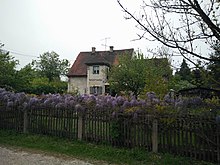Eggarten settlement

The Eggarten settlement (also Eggarten colony ) is an approx. 21 hectare historical garden settlement between the Lerchenauer See and the Münchner Nordring , as well as the Lassalle- and Feldbahnstraße in Munich Lerchenau .
history
Already around 1600 the area was called the Egern , derived from Ödgarten . A multi-field economy was operated on the poor soil until it became part of the Wittelsbach pheasantry from 1700 onwards . In the 1920s, the Bavarian Crown Estate Administration made the areas of the former Royal Pheasant Garden in the north of Munich available for settlement purposes. The settlers were given long-term leases that would last until 1999. The construction of a "main building of modest size" and "a few stables and farm sheds" was permitted. By 1926, 62 houses had been built on the site. The residents themselves took over the construction. At that time there were also grocery stores, an inn and a wooden church.
From 1938, many residents were forced to sell because a marshalling yard was planned there. In autumn 1939 some houses were demolished. In the immediate vicinity, on today's Lassallestrasse opposite the confluence of Wilhelmine-Reichard-Strasse, the Eggarten camp was built, a forced labor camp of the Freimann Reichsbahn repair shop . Other houses in the settlement were destroyed by bombing during the war.
Until 1990, the then Deutsche Bundesbahn, as the property owner of the site, planned to build a marshalling yard on the site. After these plans were abandoned, the property fell to the Federal Railroad Fund (BEV) and subsequently around 2/3 of the area to the federal real estate company Vivico Real Estate GmbH. The remaining third initially remained with the federal railway assets. With the sale of Vivico Real Estate GmbH to the Austrian CA Immobilien Anlagen AG in 2007, the property owned by Vivico Real Estate GmbH also passed to the new owner. Following a tender in December 2014, the remaining third of the site was sold by the BEV to the Büschl group of companies in 2016. In the same year, CA Immo and the Büschl Group founded a joint and equal company for the development of the area, Eggarten Projektentwicklung GmbH & Co. KG. Both companies are working together with the city of Munich to develop a structural concept for the 21 hectare area.
Today there are still 20 of the former 62 houses on 84 lots. Most residents are only allowed to use the building as a garden shed , some residents enjoy lifelong residential rights. In June 2016, tree felling by CA Immo caused resentment, at a citizens' meeting of 500 residents from Feldmoching and the Hasenbergl in March 2017, the planned development of the Eggarten was rejected and the preservation of the "green oasis" demanded.
The Eggarten is a place on the cultural history trails in Munich .
Film set
In the 1980s, the settlement served as a film set for Der Alte , and in 2000 for the Munich crime scene "Kleine Diebe" .
literature
- Volker D. Laturell : Feldmoching: the origin and development history of a Munich district: with the districts Ludwigsfeld, Hasenbergl, Eggarten, Fasanerie-Nord, Harthof and Lerchenau. Tins, Munich 1970
Web links
- Culture and History Trail District 24: Feldmoching-Hasenbergl Page 74
- They want to get rid of us SZ from June 5, 2018
- TV documentary: idyll in danger: the Eggartensiedling in Munich. (6 minutes) Bayerischer Rundfunk, June 26, 2018, accessed on May 27, 2018
- muenchen.de Projects Eggarten
- eggarten-siedlung.de Eggarten Projektentwicklung GmbH & Co. KG
- pro-eggarten.de Action Group "Pro-Eggarten"
Individual evidence
- ↑ muenchen.de - Eggarten settlement
- ^ Helmuth Stahleder : From Allach to Zamilapark: names and basic historical data on the history of Munich and its incorporated suburbs; a publication of the Munich City Archives. Buchendorfer Verlag, Munich 2001, ISBN 3-934036-46-5 , p. 63
- ↑ a b c d e f Katrin Hildebrand: Eggarten-Siedlung: A Paradise in Danger , Münchner Merkur , August 17, 2015
- ↑ https://www.sueddeutsche.de/muenchen/lerchenau-erbaut-mit-blossen-haenden-1.4598199
- ^ Eggarten in transition: Looking for contemporary witnesses , Hello Munich , March 25, 2011
- ↑ Well worth seeing: The exhibition on war, flight and displacement , Lokal-Anzeiger for the 24th district, December 21, 2015
- ↑ Lukas Eichner, Lisa Füte, Anke Oehler: “We were always hungry” - Nazi forced labor in Munich-Neuaubing , Munich empty spaces project on “Places of Forced Labor”, Ludwig Maximilians University Munich , 2015.
- ^ The work slaves in Munich , tz , May 6, 2015
- ↑ Renate Regnet: Büschel acquires parts of the Eggarten , Lokalanzeiger, February 4, 2016
- ^ City of Munich, Department for Urban Planning and Building Regulations: Eggarten-Siedlung , April 2019
- ↑ Simon Schramm: Problematic growth: tree felling in Eggarten anger local politicians , Süddeutsche Zeitung, June 19, 2016
- ↑ Simon Schramm: "Stop with the Schmarrn" , Süddeutsche Zeitung, March 31, 2017
- ↑ idyll in Danger: The Eggartensiedlung in Munich , video post on the show Capriccio of the Bayerischer Rundfunk , June 26, 2018
Coordinates: 48 ° 11 ′ 27 ″ N , 11 ° 32 ′ 12 ″ E



